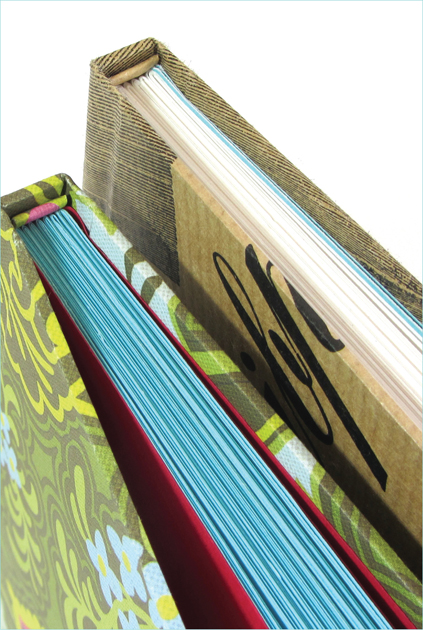

Sewn bindings can produce beautiful and highly decorative books. Creating them usually requires a number of tools—an awl, needle, thread—but they do not necessarily need to be too complicated. Sewn bindings not only bind the book, they also add unique character through choice of thread and style of stitch. Some stitches are fairly simple to create, such as the pamphlet stitch, while others are more elaborate, including Coptic and Secret Belgian, and while some stitches are intentionally exposed, others are hidden.
Examples in this chapter include some beautifully simple Japanese stab stitch bound books from Twine Bindery, experimental woven, knotted, and caterpillar stitches on books by Luisa Gomes Cardoso, and Ruth Bleakley’s Coptic and French Link stitch variations, all of which offer an engaging insight into the range of artisan processes involved in creating books by hand.

For Spanish designer Alejandro Grima Clemente, bookmaking is something that complements his graphic design work. “My interest in bookbinding began during my graphic design studies. I liked that I could experiment with materials, techniques, concepts, and ideas without any restrictions. The creative process is what I like most about it, thinking about how to transform a concept into something tangible, into a book.”
Shown here is his Sushi Book, a conceptual book created with the aim of exploring the use of different types of paper combined with a range of printing techniques. The inner pages are made up of a combination of different papers—recycled papers, colored papers, embossed papers, handmade papers, rice paper, vellum paper, and coated paper—while the cover is a textured black card stock. Clemente used the Japanese stab stitch technique to bind the book.
See also:
Japanese stab stitch


Monica Holtsclaw is the bookbinder and box-maker behind Boombox Bindery. Holtsclaw works with a range of different binding techniques, including the sewn bindings shown here.
The hardback long stitch book was created as a Christmas gift for a friend. The pages were folded into signatures and pressed. Binder’s board was then covered with book cloth to create the hardcover and a piece of wood was cut for the spine. Sewing stations were then drilled into the wood before it was sanded and then waxed. Finally, sewing stations were punched into the folds of the signatures, and the pages and cover were sewn together through the cover and piece of wood at the same time using long stitch. Once the sewing was complete, the weaving was added to the wood for durability and aesthetics.
The book Frontier Horizon was created for an exhibition by the Guild of Book Workers. For this work Holtsclaw gathered a selection of mementos, resized them, made them black and white, and copied them onto vellum paper. She then folded them into sections which would represent her past, and folded blank paper into sections that would represent her future. Three sewing stations were punched into each section so she could make a series of pamphlet stitches. The pages were then stitched onto two black pieces of Cave paper. Magnets were secured between the layers of paper at each end of the binding to hold the circle shape.
See also:
Book cloth
Long stitch
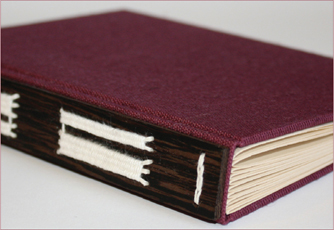


The bindery fatos&artefatos is run by Magda dos Santos Ribeiro, an anthropologist, crafter, and book lover from São Paulo, Brazil. “I am someone who lives surrounded by books; I love reading them, preserving them, and making them. I also love papers, textures, fabrics, colors, and the many possible combinations of these materials. In my anthropological research work, field notebooks are crucial, and so I decided to start making my own books using resistant materials and special papers.”
Ribeiro works using a number of different binding techniques, including many sewn bindings. Shown here is a selection of her Coptic bindings, including a Coptic cross-stitch. “I chose to combine Coptic and French stitch because Coptic has a more resistant and smooth finish, but I wanted to use French stitch for detail and as a way of enhancing the spine of the book,” she explains. “It is not hard to do, the techniques are the same, and this is a big attraction of bookbinding; you can combine different techniques, lines, materials, papers, and stitches in the same book.” Working with different patterned book cloths and brightly colored threads, Ribero’s work is beautifully bold and graphic.
See also:
Coptic stitch
French link stitch
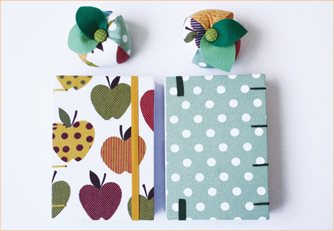


Experiências Manuais translates as “handmade experiences” and is what the founders of Corrupiola, Leila Lampe and Aleph Ozuas, aim to create within their design and craft work. These notebooks, part of their handmade stationery, are called Corrupios, meaning “a child’s play” in Portuguese.
Together they design, screenprint, and bind these small notebooks one by one, using colored Fabriano Tiziano paper for the covers and acid-free 80gsm pollen paper for signatures. Each book is hand-sewn along the spine using simple pamphlet stitch.
“These mini notebooks were designed to be practical and the vivid cover colors were designed to be easily found in a purse or on a messy desk. They are made from leftover paper used for other notebooks. We like to make small products and to make the most of any paper that we have left over.”
See also:
Pamphlet stitch

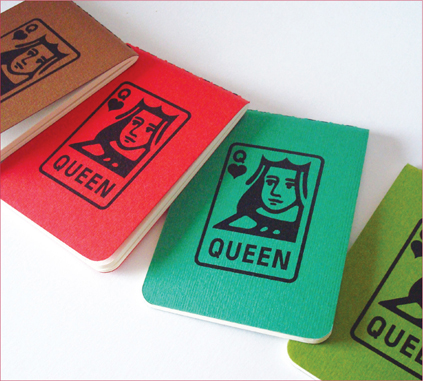

Yuko Murata Godart of Coffee Monkey Press learned traditional bookbinding techniques in the UK and Japan. She now resides in Los Angeles where she works as a bookbinding artist. Inspired by a love of coffee and cafes (the clue is in her choice of company name), Godart’s book experiments with the conceptual side of bookbinding.
“I had a lot of fun making this. It was a combination of problem-solving, happy coincidence, and pushing my desire to make a playful coffee-themed book. I wanted to somehow incorporate actual coffee beans into the book and at around the same time I was experimenting with Japanese stab binding. As much as I loved the technique, I found the spine too plain, so adding a coffee bean to it was the perfect solution.”
Godart sourced fabric featuring a coffee bean-like design (actually called “Screw head”) for the cover and dyed the pages inside the book using coffee, so when the book is freshly made, the smell of coffee wafts up as the pages are turned.
See also:
Japanese stab stitch

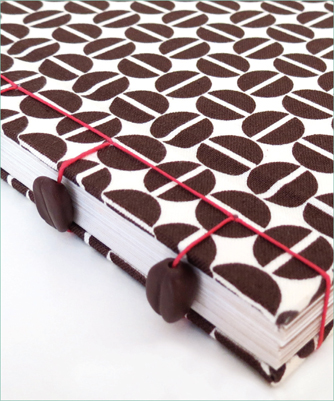

Inayza is the studio name of artist and designer Gina Nagi. “Design has been a big part of my life growing up. My work focuses mostly on detail, be it color choice, paper textures, or stitching, and I love mixing different mediums together to create unique pieces. Through my work I want to create objects that establish a special bond between the buyer and me.”
Shown here are Nagi’s books that have been bound using Coptic stitch. The sketchbook made with wrapping paper contains a combination of three stitches: Coptic, kettle, and long stitch. Nagi’s beautiful cloth-bound board books are decorated with patterned paper.
Nagi works with various materials, including different papers, recycled and gift, leather, linen, threads, and even lace. Each of her books is hand-sewn using linen thread. Canson paper is used within for the pages.
“The Coptic binding technique is relatively new to the Egyptian book market. I decided to use it as a way to be unique as a bookbinder here and appeal to people who would appreciate this creative form of bookbinding.”
See also:
Coptic stitch
Long stitch
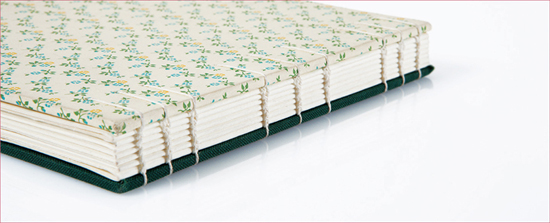
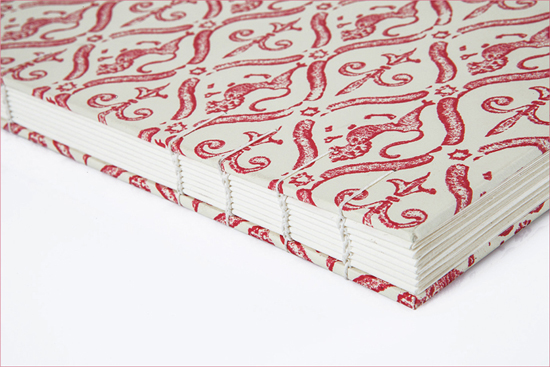

Iris Grimm runs Grimm Books, a small, independent bookbindery that places an emphasis on quality craftsmanship and attention to detail. “I strive to combine innovative design and techniques with the centuries-old art of bookbinding to create books that are modern and functional.”
Grimm specializes in hand-sewn bindings primarily for custom-made journals, guestbooks, and photo albums, as shown here. All the components for each of her books are measured and cut to size before being assembled by hand. “I cover the boards in cloth, fold the pages, measure, mark, and pierce the sewing stations on the folios and spines, and then prepare to bind them.” Her books and journals feature a variety of different stitches, including double-diamond cross-stitch, contiguous cross-stitch, diamond cross-stitch, lattice stitch, long stitch, and two-needle Coptic stitch. Grimm uses these stitches for both their durability and aesthetic value.
“I love that I am creating things every day, and that I am making something handmade that people will use and treasure.”
See also:
Book cloth
Coptic stitch
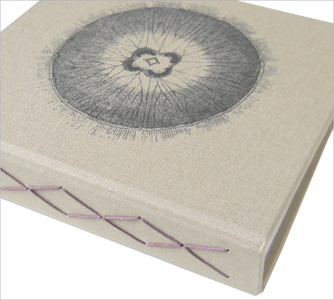
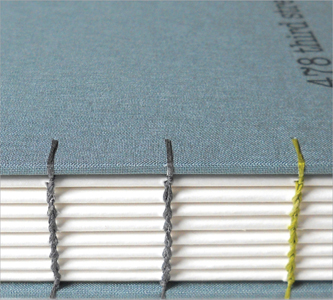

RAMA is a group of graphic designers based in Buenos Aires that specialize in bookbinding and letterpress printing. Shown here are examples of their sewn bindings.
The book Ideas features Coptic binding and a letterpress-printed cover. It is part of a series of Coptic notebooks that have covers printed with old wooden type and metal engravings.
Write It Down features Secret Belgian binding, chosen for the pattern it creates on the spine and cover. “It is a unique and beautiful technique,” say Sergio Plano and Natalia Cañas. “With the cover we wanted to create something quiet, easy, soft, and subtle, which is why we used a soft cloth with a goffering on top of it.”
The stocks used to create both books were ⅛" (3mm) cardboard for the covers, Bookcel 80gsm paper for the inner pages, and Fabriano 120gsm for the endpapers in Write It Down.
See also:
Coptic stitch



Shown here is Brazilian graphic designer and illustrator Antonio Rodrigues Jr.’s book titled Love. In it he shares lyrics from one of his favorite songs, combining three of his passions—typography, craft, and poetry. Fifty copies were hand-crafted to celebrate Valentine’s Day.
“I have a passion for crafts and paper. When I was a child I used to spend hours in stationery shops and warehouses. Now it has become one of my greatest (and easiest) ways to escape from a hectic day of routine.”
Rodrigues has used Japanese stab stitch to bind the book, marking the holes, and then using a nail to create stations to stitch through. Cotton paper was used for the inside pages, with the cover made using boards and craft paper.
See also:
Japanese stab stitch
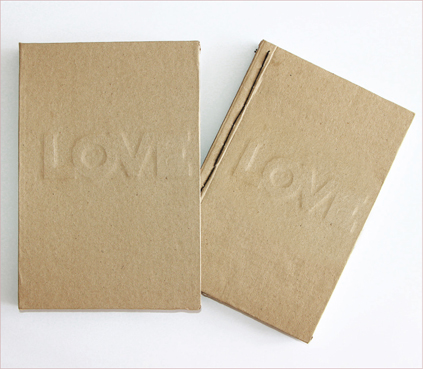
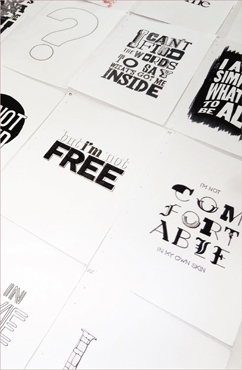

Gabriela Irigoyen is a Rio-based designer and bookmaker who takes an experimental approach to book design. “I like to create books with the intention to grab people’s attention. Whether that is through size, stitching, or the colors I work with, I am always searching for something that will catch people’s eye.”
Shown here are her takes on long stitch binding; the star design was made by stitching a loop to hold the threads together. These decorative stitches not only add to the aesthetics of the books, they are also strong and durable. Both add beautiful detail to the spine. Irigoyen creates the spines using a modified Bradel technique, which gives a finer finish.
See also:
Long stitch
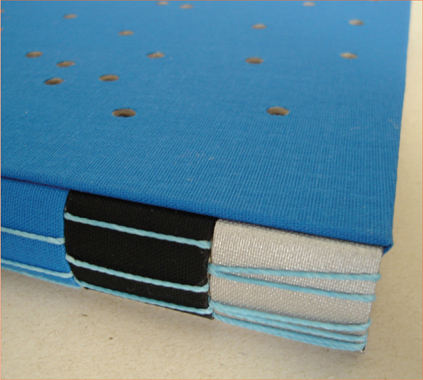


For Chinese-born Jiani Lu, a childhood spent doodling and making papercuts, jewelry, and origami meant that she was destined to have a creative career. “I design, photograph, and illustrate, and I have an unbound curiosity for new mediums and creative processes. Over the years my experience in crafts and design has translated into a key interest in package and print design, bookbinding, sewing, and paper crafts. I see each new project as a learning experience, allowing me to experiment with the process, materials, and aesthetics.”
Shown here are two books that she has created using Coptic and saddle stitch. Tea-Hee, a book about the art of tea-making, features handmade front and back covers using canvas fabric. The pages have been divided into four signatures and bound together using Coptic stitch, which Lu chose as this binding allows the book to lay flat when open.
For Window Farms, an all-in-one guide for urban farmers on window farming, Lu employed an accordion format with the five different sections (chapters) sewn together using saddle stitch. “I used an accordion format for this book to allow for various approches to reading. When collapsed together it reads front to back like a regular book. When expanded open, it reveals the entire length of the book with the ability to reference content from several chapters all at once.”
See also:
Accordion book
Coptic stitch
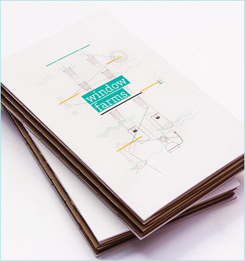
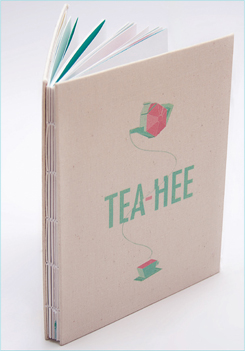

“I have always loved notebooks and journals and consider myself a compulsive list-maker,” says Eileen Pandolfo of Twine Bindery. “I also love to create things, so the idea of making my own journals and books is where Twine Bindery all began.” Each of Pandolfo’s books are created by hand. Once the covers are designed and illustrated she prints all the different parts of the books, punches the holes, corner-punches everything, glues the binding, adds a pocket, scores it, then binds it all together. She favors the Japanese stab stitch binding method and uses it for all her books. The covers are made using 300gsm Strathmore watercolor paper or 100 percent recycled Kraft stock.
“I love the design process that goes into creating a notebook or journal. When I get an idea, I have to immediately drop what I’m doing and run with it. I then really enjoy going through the steps to make and perfect what I have visualized and designed.” The illustrated cover design for the One-of-a-Kind Tribal pocket journal was created by Pandolfo’s 14-year-old daughter with a fine-tip Sharpie marker.
See also:
Japanese stab stitch
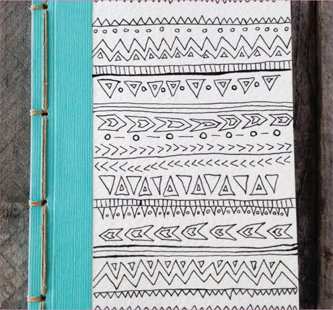


Satsuki Shibuya is a designer, singer-songwriter, and creative consultant based in Los Angeles. Inspired by nature and the different seasons, she created this weekly planner, which she chose to bind using buttonhole stitch. “One of the things I associate seasonal changes with is the changing color of leaves. I used this as my inspiration and began gathering pictures before starting to bring patterns together. I then created six different hand-drawn patterns within the book, which are graphic interpretations of leaves.”
Shibuya has used buttonhole stitch as she wanted the book to lie flat when open. “It is a beautiful and unique stitch, and felt like the perfect fit for the project size and function.” The cream cotton cover stock has been letterpress printed.



Sprouts Press is a small press and bindery run by designer and maker Carolyn Eady from her home studio in Toronto. Her main focus is on hand-bound books, journals, sketchbooks, and notebooks, created using a variety of sewn bindings, although she also loves screenprinting, drawing, and painting.
For her bookbinding Eady uses new and recycled boards, found papers, handmade papers, Florentine papers, chiyogami papers, and washi papers, among others.
“The functionality of the book structure and how it can be designed to suit certain activities, such as watercolor painting or writing, has shaped many of my book projects.” This journal is part of a series and is bound together using the Secret Belgian binding technique. Eady chose this technique as not only does it allow a book to be opened flat, it also allows the front cover to flip around to the back. The Secret Belgian binding also maximizes page access, since all corners of the page can easily be used.
Patterned Florentine paper has been used on the cover, complemented with accent paper on the spine and fore edges of the cover, and finished with a ribbon trim where the patterned paper meets the accent paper.

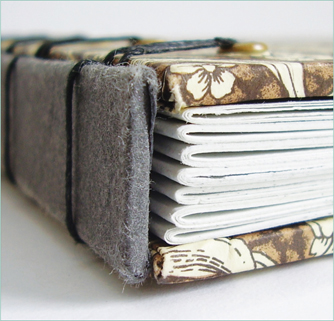

Kristi Oliver of Olive Art is both a book artist and teacher of creative arts. She started bookbinding using the Coptic method early in her teaching career and has since made hundreds of books.
“I love the finished books I create. They are like little (or sometimes big) treasures. I love seeing what people use them for and what they might include inside. I also really enjoy creating custom items to commemorate weddings and other special occasions, and trying to reflect my own self as an artist while incorporating special touches to honor the recipient of the book.”
Shown here are two of Oliver’s Coptic-sewn books, made using a variety of different materials including security patterns from used envelopes and nautical charts. “I created the nautical books after seeing a pile of outdated nautical charts at a boat yard. I had been using roadmaps for some time and have always loved the way they suggested an adventure (past or present) and an attempt to document some sort of journey, either actual or imagined.”
Oliver has used the Coptic stitch (sewn with waxed linen thread) for its strength and the fact that it allows books to lay flat when open.
See also:
Coptic stitch
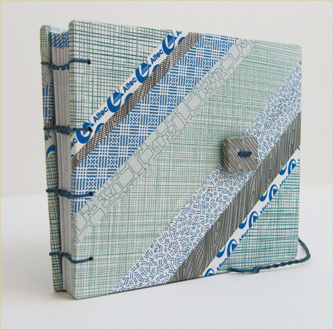


For Rio-based bookbinder Luisa Gomes Cardoso, the art of bookbinding is all about experimentation. As well as using traditional bindings Cardoso likes to develop her own unique stitched bindings, which stem from her love of sewing.
“I learned to sew when I was a child with my mother. My love for needlework comes from my mother and grandmothers, my love of books from my father. I began by sewing clothes but very soon I was sewing books. My challenge with my bookbinding is to apply the techniques of sewing, embroidery, and knitting that I have learned to the art of bookbinding.”
The selected works shown here feature many different experimental bookbinding stitches, including a knitted binding and a caterpillar stitch. The books shown opposite, from smallest to largest, feature ladder stitch, a pantographic binding, loop stitch, and a Portuguese knotted stem stitch.
As a rule Cardoso uses leather board for the covers of her books, which she then paints by hand with a thin layer of wax. She uses nylon, waxed, or traditional embroidery threads to bind the books together.
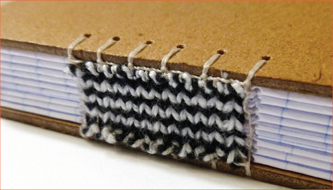


Ruth Bleakley is a Florida-based designer, book artist, and teacher. She specializes in Coptic-bound books and variations on the Coptic stitch. “Coptic stitch is definitely a favorite among my customers at craft shows. Most likely because it’s impossible to accomplish by machine, and so you’re unlikely to find it in bookshops. I enjoy using this method because it creates a journal that lays flat when it’s opened, which means it’s easier to write in. It’s also a great-looking binding, with the braid on the outside spine of the book.”
Bleakley often uses nautical maps for the covers of her books, however she also uses washi tape, marbling, and other papers.
“I usually start with the cover paper first, choosing the part I’d like to make into a book, and then work back from there, deciding the eyelet color and thread color after the cover is cut out,” she explains. The French link variation stitch book was one of her first experiments in open-spine stitching. “Normally this stitching would be hidden from view by the spine, but I thought it would look neat to show it.”
See also:
Coptic stitch
French link stitch
Suminagashi paper marbling
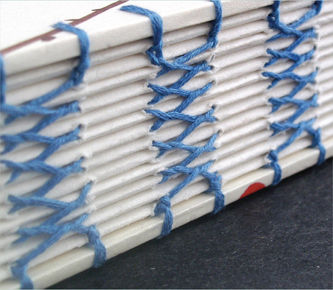


Odelae is run by graphic designer and bookbinder Erica Ekrem from her home on Orcas Island, Washington. Ekrem’s designs are largely inspired by nature, folk tales, and the environment around her. “Odelae journals are born from faded, timeworn materials that have survived from the early 1900s. My inspiration is discovered in old chests and bookstore salvage boxes. From materials that are no longer valued or falling apart, I reclaim what is remaining and revive it.” Her Field Journals shown here were created as places to record observations in nature. The stitched star pattern on the spines was inspired by the sky at night and the idea of recording constellations within a book.
The covers over the textblocks have been made using an upcycled vintage book cover. The spines have been strengthened with a strip of leather, the textblocks are smooth writing paper, and the inner covers are lined with velvet paper. Ekrem has alternated the color of the signatures to give the books a feeling of whimsy and playfulness. They have been stitched together using long stitch.
See also:
Long stitch

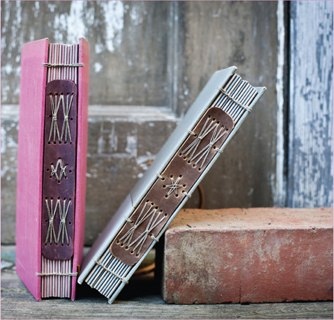

Jen Collins, otherwise know as hellojenuine, is an illustrator working in pencil and ink, with a love of screenprinting. Shown here is one of her limited-edition hand-bound screenprinted notebooks featuring her illustration of a perpetual bicycle.
Collins has used the simple yet sturdy pamphlet stitch to bind the notebook together, which allows for the book to be opened fully flat when bound.
“Screenprinting and binding can be therapeutic processes. Although it’s a time-consuming method, it means I can do each step myself from start to finish, therefore overseeing the item throughout its creation.”
Collins uses recycled card and paper supplied by Eco-Craft to create her notebooks. “I make a point of using recycled stocks for my notebooks, as they use up more paper than other things I make, so I like that the contents are being used again. The recycled paper I use on the inside isn’t so thin that drawings show through; I like that, and I like that it isn’t a stark white.”
See also:
Pamphlet stitch



AG&P Handmade is run by freelance graphic designer Rima Bueno. Shown here are a number of her books which feature sewn bindings, both Coptic stitch and long stitch.
“My Coptic-bound books feature a fairly utilitarian design. I like to keep them clean and simple. Because these books are intended for use as sketchbooks or creative journals, I don’t want to impose a direction on the content.” Bueno has chosen Coptic stitch as it is particularly good for sketchbooks, allowing the pages to lay flat when open.
The book Wonderland sees Bueno incorporate her interest in printmaking and typography into bookmaking, while the mini books were created as experiments to test stitches, both long and Coptic.
See also:
Coptic stitch
Long stitch
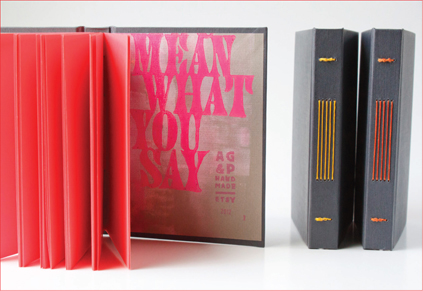


Bookbinder and artist Amy Egerdeen runs Nightjar Books, where she draws and creates designs for covers, makes zines, screenprints, and binds books. “I love being involved in every aspect of my work. I draw, using ink and a brush, and create patterns from my illustrations. I screenprint all my covers, brainstorm new book ideas and new designs.”
The books shown here feature Egerdeen’s illustrations of houses, arrows, axes, the moon, and more. She takes these illustrations and creates patterns with them in Photoshop, before making a screen from which to print onto her chosen cover stock. Once the different elements of the books are assembled she uses beeswaxed linen thread to sew each book using Coptic stitch.
“These books come from a blending of my love for Coptic-bound books and new ideas for patterns and cover designs. I really love illustrating and creating patterns for the covers of my books, and of course the binding itself. When I sew the signatures to the covers it is great to feel it all come together.”
See also:
Coptic stitch
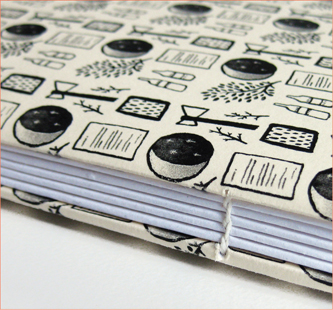
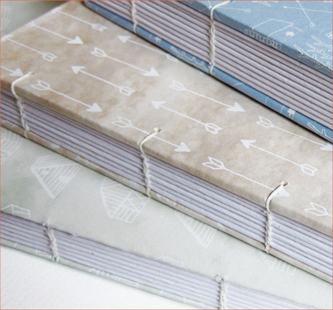

Becca Hirsbrunner has bound books in a number of different styles and methods but specializes in Japanese stab binding. “I want to see how far I can push the limits of a particular style of binding, especially Japanese stab binding. I like taking a complex sketch and figuring out how to make it work within the limitations of the style. I especially enjoy creating organic designs, since most sewing patterns are strictly geometric.”
Her different stitch styles can be seen here, including a dragonfly stab pattern and a marionette pattern. “There is a certain type of rhythm to complex stab binds, but once you figure that rhythm out, the design possibilities are endless. For instance, before creating the marionette stitch I had created a number of simple geometric binds using squares and single triangles. But then I thought, why not try overlapping multiple triangles together?” Hirsbrunner drills holes in her book blocks before creating her stitched patterns using waxed linen thread.
See also:
Japanese stab stitch

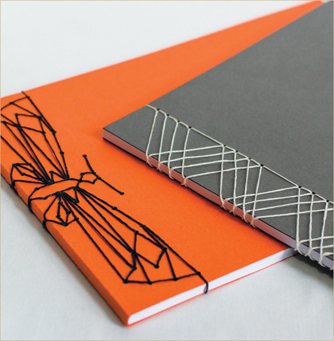

Louise Walker is a graphic designer who also works in illustration, screenprinting, typography, and bookmaking. “These days in graphic design a lot of the work requires you to use the computer. That is why I love taking any chance I can get to step away from technology and get back to the basics with crafts like bookbinding, an actual hands-on method of production.”
The travel journal shown here features Walker’s design on the cover, which she affixed to craft board before assembling together with the inside pages ready for binding. She has used Coptic stitch to bind the journal, mainly for aesthetic reasons. “I love the handmade appearance the Coptic stitch creates, and it suits the style of my travel journals perfectly. I like the fact that it gives you full control over the bind, i.e. how tight the thread is, how many pages in each signature, how many holes to punch, and, of course, thread colors. One thing that perhaps people do not realize is that even as the book ages, and the thread of a Coptic stitch loosens over time, the pages still stay together. The pages will never fall out.”
See also:
Coptic stitch
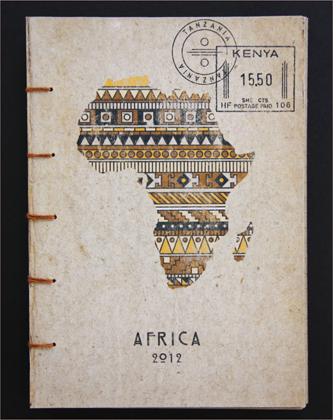


Gabriela Irigoyen is a Rio-based designer and bookmaker. The book shown here features a technique that involves sewing raised cords onto the cover. The signatures and the cloth-bound board covers of the book are first sewn together using Coptic stitch on the spine. Cords are then added from the back to the middle two stitches, which are then sewn around and onto the cover using embroidery thread. This technique adds beautiful texture and detail to the cover, and the cord can also be wrapped around the closed book and used to secure it. Beads have been added to the end of the cord to aid the secure closure.
See also:
Coptic stitch
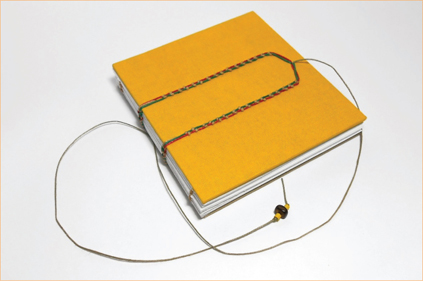


Based out of Minneapolis, West Cermak is a collaboration between designer and creative Trinh Mai and artist and printer Jeffrey Nelson. With the products they create under the name West Cermak they try to combine new and old materials, scavenging thrift stores and specialty stores for antique items, and repurposing materials that would otherwise be thrown away. The cover of the book Mountain features a vintage photograph of a mountain.
To bind the books they use book cloth, waxed linen thread, paper, and, for some projects, screenprinting. Mai favors the use of a Coptic stitch or simple five-hole pamphlet stitch to bind her books. “I like using these techniques because they enable me to create a visually interesting, yet clean spine, and in the case of the Coptic stitch it allows for the books to lay flat when opened.” Mai also uses reclaimed paper stocks where possible.
See also:
Book cloth
Coptic stitch
Pamphlet stitch
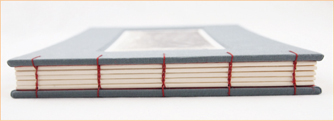

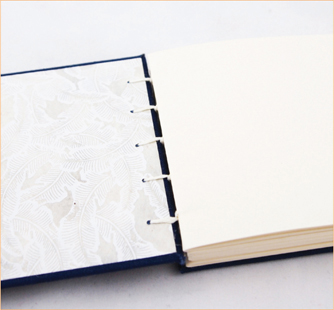

Based in Quzhou, a small city in eastern China, self-taught bookbinder Hu Jin runs H&G Handmade. She uses many different materials to create her books, such as linen, paper, leather, metal, clay, and wood. She also likes to combine different materials and experiment with the effect these combinations have. Jin has done exactly this with the leather and linen book shown here. She has used a simple cross pattern on the linen cover and lines on the leather spine.
Both books were created by first cutting two boards for the cover and attaching them with a thick paper. The thick paper was also used to create the molded spine. Jin then glued the cloth onto the board to create the case. Once the inside pages were ready she then bound the books using the long stitch binding technique. “I chose this binding as it enables the book to be filled with many pictures without losing its shape. It also allows the spine to be as flexible as possible. When designing and making a long-stitch-bound book using leather, it is important to match your materials well. I always pay attention to the shape of the body of the book and the shape of the parts on the cover.”
See also:
Long stitch
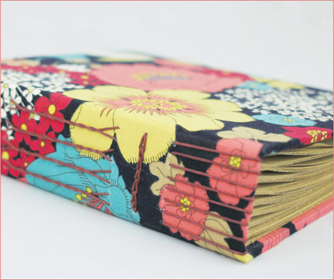
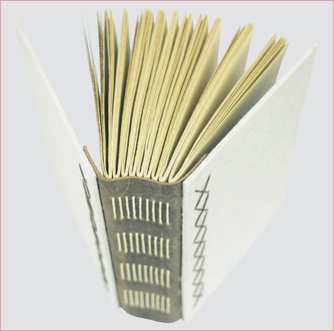

Team Art is run by Amanda Lo and Charline Wang, who together make paper goods, with their forte being handmade coloring books. All the humorous books are based on topics that they love, full of puns, and aim to entertain. “The first coloring book we created was Boy Bands: A Colouring Book. We put it online and it quickly grew to be very popular. We decided to expand and rebrand the idea to create a set of animal and pop culture coloring books, including ones on Parks & Recreation, Jon Hamm, funny ladies, Mad Men, and Game of Thrones.” Illustrator and InDesign are key programs used to create the drawings, designs, and prepress work. Once all the essentials are printed, the books are individually assembled by hand. The next step is running the books through the sewing machine to bind the pages, then the creep is trimmed with a guillotine cutter. The binding process is completed with a bellyband and stamped with the title.
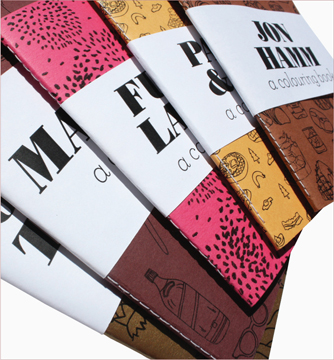
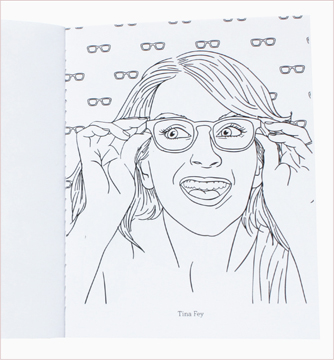

Wendy Withrow is a bookbinder and box-maker working out of her home studio in Grand Rapids, Michigan. Through Windy Weather Bindery she aims to marry the traditional craft of bookbinding with the best of contemporary materials and design. “I aspire to make well-crafted, utilitarian objects that are simple, beautiful, and bring joy to the daily lives of others. I specialize in custom hand-bound books and boxes for a variety of clients, including photographers, designers, and artists.”
Working primarily with cloth and paper, but also occasionally with leather, she case-binds many of her books using the German millimeter binding, an elegant and clean binding that traditionally utilizes leather at the head and tail to add durability to the binding, although in Withrow’s case she also uses cloth. “I particularly like the millimeter binding because it adds strength to the corners and the head and tail, which are areas that are often damaged easily. I love the elegance of it, with the straight clean lines as opposed to the traditional half bindings which cover the corners with cloth at a diagonal. I also like that it showcases the paper over the cloth.”
Withrow also favors Rubow binding, a Danish variant on millimeter binding.
See also:
Case binding



Based in Phoenix, Jennifer Bates of Sea Lemon is a graphic designer by trade, but outside of her full-time work as a designer she makes books and paper goods and creates online DIY projects. “I really enjoy the process of designing a custom book, choosing the materials, and exploring binding methods to make a unique, functional book. I like to work with a variety of papers and threads to create unique or modified stitch bindings.”
The case-bound books shown here were created to be used as journals or sketchbooks. To make the books Bates first created the textblocks then used the cover paper to make decorative headbands. These headbands have been glued directly onto the textblock spine.
Next, the case, or cover, is made using a corresponding decorative paper. The paper is applied to book board and then the textblock is glued into this case.
See also:
Case binding
